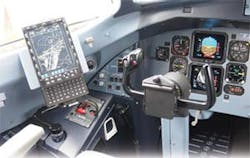In the world of airframe manufacturing, it is a well-known fact that an aircraft is not considered airworthy until the weight of the supporting documents is equal to the empty weight of the machine. Certification is only the beginning as there are hundreds of thousands of pages necessary to provide for the continued support and operational capabilities of the aircraft.
It is still a common occurrence to observe pilots in transit carrying catalogue cases weighing upwards of 40 pounds. When I have questioned the content, the official response has always been, “it is full of navigational charts.” This answer does have some validity as Federal Air Regulation 91.503 states that pilots of large turbine-powered aircraft shall have aeronautical charts and data, in current and appropriate form that are accessible for each flight at the pilot station of the aircraft.
So what is an electronic flight bag (EFB)?
The official Federal Aviation Administration (FAA) definition is:
Electronic Flight Bag (EFB). An electronic display system, intended primarily for cockpit/ flightdeck or cabin use. EFB devices can display a variety of aviation data or perform basic calculations (e.g., performance data, fuel calculations, etc.). In the past, some of these functions were traditionally accomplished using paper references or were based on data provided to the flight crew by an airline’s “flight dispatch” function. The scope of the EFB system functionality may also include various other hosted databases and applications. Physical EFB displays may use various technologies, formats, and forms of communication. These devices are sometimes referred to as Auxiliary Performance Computers (APC) or Laptop Auxiliary Performance Computers (LAPC).
Aircraft operators have long recognized the benefits of portable electronic computing devices, including commercially available portable computers, to perform a variety of functions traditionally accomplished using paper references. EFB systems may be approved for use in conjunction with or to replace some of the hard copy material that pilots typically carry.
EFBs can electronically store and retrieve documents required for flight operations, such as the general operations manual (GOM), minimum equipment lists (MEL), operations specifications (Op Spec), and control documents. Maintenance discrepancy logs can also be created and stored but do need to be downloaded into a permanent record at a predetermined frequency.
Three classifications
They come in various packages with differing degrees of capability and complexity. Availability includes carry-on, entirely self-contained devices to those units that are completely interfaced into the aircraft flight deck. Due to the one size does not fit all concept, the FAA has categorized EFB’s into three classifications.
The Class 1 EFB: Generally commercial-off-the-shelf (COTS)-based computer systems used for aircraft operations; portable; not attached to an aircraft mounting device; not required to go through an administrative control process for use in the aircraft depending on application; and considered portable electronic devices (PED).
The Class 2 EFB: Generally COTS-based computer systems used for aircraft operations; portable; connected to an aircraft mounting device during normal operations; has to go through an administrative control process to add, remove, or use in the aircraft; and considered PEDs.
System power, data connectivity, and mounting devices require Aircraft Evaluation Group (AEG) evaluation and certification approval.
The Class 3 EFB: Installed equipment that will require approval, except for some user modifiable software. Class 3 EFB system certification requirements may enable additional applications and functions.
The EFB may provide a platform for running a significant number of functions which is dependent on internal software category:
Type A software will provide document viewers such as PDF which will display various electronic versions of navigational charts and even crew checklists. In addition it can store and present on command operating manuals or other printed documents. This type software will frequently possess computing power to enable aircraft performance calculations to be tabulated.
Type B software will also provide charts but they become somewhat interactive allowing crew members to zoom, center, and perform navigation planning functions with information obtained from GPS input. In addition, the display unit can provide visual images obtained from enhanced vision systems (EVS), on-board cameras, and even real-time digital weather.
Type C software will enable the EFB display to serve as a multi-function display (MFD) and has the potential to allow the system to qualify as a moving map and thereby allowing it to function as part of the ADB-S system. These capabilities make this version of software subject to various airworthiness requirements including software certification and must only run on a Class 3 EFB.
Installation & features
Installation of EFBs should require extensive preplanning. In some cases locating the display on a control column may require involvement of the aircraft manufacturer to determine if the weight will have any adverse effects. Power or data cables could also interfere with control deflection. In order to maintain the Class 1 or 2 status, any aircraft data provided to the EFB can not corrupt aircraft systems in the event of an EFB malfunction.
FAA AC 120-76A provides guidance and definitions regarding the installation and usage of EFBs in aircraft. This document should be mandatory reading for anyone planning to include this type of technology in any aircraft.
Components include two line replaceable units: a lightweight, compact and self-contained electronic display and processor unit (EDU); and a companion expansion module unit (EMU).
The EDU contains a screen for viewing information and has a touch sensitive coating to allow simplified crew interaction with various applications. One part of the EDU does function as a data processor. Like most PCs, it does contain an internal battery so it can function even without aircraft electrical power. Battery endurance is dependent on the display backlight intensity and processor use so duration will range from 30 minutes to almost two hours.
Like most electronics, heat dissipation is a concern and like most PCs the EDU includes circulation fans that are thermostatically controlled. Cooling air enters through ventilation openings and one of the few maintenance tasks with this unit is to ensure the air paths are clear of obstructions. And an internal diagnostic system keeps tabs on system operations and records any observed anomalies.
Two USB ports are provided on the EDU for loading revisions for the various data bases.
Keyboards can be utilized to interact with the EFB or send text messages either through a wireless network or Ethernet cable providing a direct link to an onboard telecommunication system. This will enable data communications with Air Traffic Control (ATC) as well as an email connection with dispatchers or maintenance personnel and even launching a web browser.
Display of digital weather is another capability. This can be enabled by subscribing to a service such as WSI or installing an XM Radio receiver and antenna.
An EFB can have a wide range of capability. It is capable of storing all the information required to operate and even support an aircraft. It can provide communication links including web access and even interface with other devices to display digital weather or to enhance vision.
The EFB can provide virtually a paperless cockpit. Like its 40-pound predecessor, it can even provide storage for a ham and cheese sandwich, virtually!
Jim Sparks has been in aviation for 30 years and is a licensed A&P. Currently when not writing for AMT, he is the manager of aviation maintenance for a private company with a fleet including light single engine aircraft, helicopters, and several types of business jets.
About the Author

Jim Sparks
Jim Sparks has been maintaining aircraft for almost 40 years with the majority of the time involving Business Aviation activities. Jim’s endeavors have placed him on six of the seven continents contending with numerous situations from routine flight dispatch to critical AOGs. His career includes maintainer, avionics/electrician, educator, tech rep, and director of aircraft maintenance. In addition to other activities he is engaged with ASTM assisting in the global development of criteria defining the Next Tech for NEXTGEN. You can reach him at [email protected].
